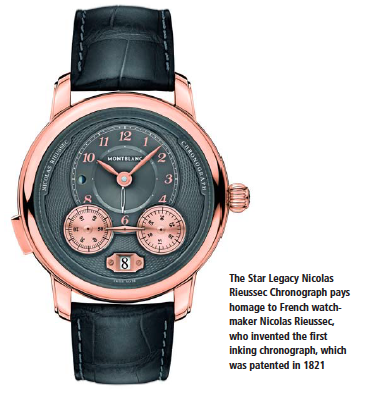 Building legitimacy
We are seated in modern Italian restaurant 28Wilkie, where a select group of specialist watch journalists are gathered for an exclusive preview of Montblanc’s 2019 timepiece novelties. The event was held last November, ahead of the annual Salon International de la Haute Horlogerie (SIHH) this month in Geneva.
Bespectacled Cerrato is dapper as always, exuding creative finesse in a navy blue jacket paired with cream-coloured trousers and chestnut shoes, while a printed bow tie and pocket square complete his ensemble.
Amiable and on occasion witty, it is immediately obvious why Cerrato has become an industry personality the media is rather fond of. He has a relaxed air about him and we slip into conversation easily, beginning with the biggest challenge he faced when he arrived at Montblanc from Tudor.
“The biggest difference is that Tudor, which is part of the Rolex portfolio, is a specialist in the watch category, and the challenge was [establishing] Tudor’s positioning next to Rolex: something complementary and expressing the same excellence,” he says. “Whereas Montblanc is a multi-category brand known for its writing instruments; its watches arrived later, which poses completely different challenges.”
Surmounting these challenges will require Montblanc to continue building “a serious, strong, legitimate watchmaking language”. Approximating the brand to be in the middle of this task, he says: “We need to show, explain and be able to argue why we are as good as a specialist watch brand.”
Building legitimacy
We are seated in modern Italian restaurant 28Wilkie, where a select group of specialist watch journalists are gathered for an exclusive preview of Montblanc’s 2019 timepiece novelties. The event was held last November, ahead of the annual Salon International de la Haute Horlogerie (SIHH) this month in Geneva.
Bespectacled Cerrato is dapper as always, exuding creative finesse in a navy blue jacket paired with cream-coloured trousers and chestnut shoes, while a printed bow tie and pocket square complete his ensemble.
Amiable and on occasion witty, it is immediately obvious why Cerrato has become an industry personality the media is rather fond of. He has a relaxed air about him and we slip into conversation easily, beginning with the biggest challenge he faced when he arrived at Montblanc from Tudor.
“The biggest difference is that Tudor, which is part of the Rolex portfolio, is a specialist in the watch category, and the challenge was [establishing] Tudor’s positioning next to Rolex: something complementary and expressing the same excellence,” he says. “Whereas Montblanc is a multi-category brand known for its writing instruments; its watches arrived later, which poses completely different challenges.”
Surmounting these challenges will require Montblanc to continue building “a serious, strong, legitimate watchmaking language”. Approximating the brand to be in the middle of this task, he says: “We need to show, explain and be able to argue why we are as good as a specialist watch brand.”

 Recreating history
Known for his love for all things vintage (classic cars in particular), Cerrato has dipped into Minerva’s treasure trove of archives for inspiration for Montblanc’s brand-new Heritage Collection, unveiled at the 2019 SIHH showcase.
The collection, inspired by historical Minerva classic wristwatches from the 1940s and 1950s, flaunts vintage aesthetics such as domed dials in colours evocative of that era like salmon, smoked caramel and silvery white, as well as chronograph markers that recall the use of old-school payphones.
Cerrato is no stranger to uncommon dial colours. Last year, he introduced the 1858 Chronograph Monopusher with a smoked green dial matched with a British racing green alligator strap.
“Before that, there were no green watches. Don’t ask me why. Perhaps it’s linked to bad or good luck. In the theatre, for example, they avoid green because they say it’s bad luck. We jumped into [the project] with a very special green sunray dial and it was a huge success. Now, other brands are launching green watches almost every week,” he observes.
Another unusual choice of colour Cerrato had previously deployed is burgundy. “When I did the Heritage Black Bay Burgundy Bezel with Tudor, -burgundy was not really used on the bezel of a diving watch. It was completely unusual, but it was one of the elements that made this watch striking,” he says.
Cerrato clearly enjoys pushing creative boundaries. “With materials, colours, finishing, shapes, you can do many things and bring strong character to the watch,” he notes.
I ask if there is something that Montblanc watches will never do. “Very nice question,” he responds. After a few moments of thought, he says: “Never say never. We are doing connected watches so…”
He is referring to the new Summit 2, which resides on the avant-garde end of Montblanc’s spectrum of horological offerings and certainly makes for an interesting talking point, as the smartwatch is so diametrically opposed to all the heritage-speak.
“I think the Montblanc watch customer is evolving quite dramatically,” Cerrato points out. “It used to be a very classical watch customer and perhaps an entry-level customer. But now, we are building up the manufacture offerings for second- and third-level connoisseurs and watch lovers who were not used to coming to Montblanc because they felt we were not doing enough sophisticated executions,” he explains.
He believes the brand is “in the middle of a customer shift” and he is focusing on extending its customer reach by creating a wider range of watch products across three price tiers — -entry-level, mid and high — that will be commensurate with varying degrees of technical complexity to encourage customers to “grow within the brand”.
“The strategy is to provide a continuum for a young customer who may buy an entry-level watch to be able to upgrade to a watch with an in-house movement as he improves his knowledge, and then even go for something more sophisticated like a Chronograph Monopusher if his career is going well and he has the means. It is quite rare to be able to have this within one brand. Normally, you start low, then you need to jump to different brands to go up [to more complicated models],” he says.
Does Cerrato hope to convert customers buying the connected watches to mechanical watch connoisseurs?
“It’s completely different. [The connected watch buyers] are more digitally savvy; they are young people who buy every new technology. That said, we hope that by building a relationship with the brand, they may want to get their first mechanical watch when they start to work, and then they can also join the [horological] journey. But in the short term, we know that they come to buy other product categories within a similar price point,” says Cerrato.
A pretty clever move for a multi-category luxury brand to strategically secure both ends of the market, and then some.
This article appeared in Issue 865 (Jan 21) of The Edge Singapore.
Subscribe to The Edge now
Recreating history
Known for his love for all things vintage (classic cars in particular), Cerrato has dipped into Minerva’s treasure trove of archives for inspiration for Montblanc’s brand-new Heritage Collection, unveiled at the 2019 SIHH showcase.
The collection, inspired by historical Minerva classic wristwatches from the 1940s and 1950s, flaunts vintage aesthetics such as domed dials in colours evocative of that era like salmon, smoked caramel and silvery white, as well as chronograph markers that recall the use of old-school payphones.
Cerrato is no stranger to uncommon dial colours. Last year, he introduced the 1858 Chronograph Monopusher with a smoked green dial matched with a British racing green alligator strap.
“Before that, there were no green watches. Don’t ask me why. Perhaps it’s linked to bad or good luck. In the theatre, for example, they avoid green because they say it’s bad luck. We jumped into [the project] with a very special green sunray dial and it was a huge success. Now, other brands are launching green watches almost every week,” he observes.
Another unusual choice of colour Cerrato had previously deployed is burgundy. “When I did the Heritage Black Bay Burgundy Bezel with Tudor, -burgundy was not really used on the bezel of a diving watch. It was completely unusual, but it was one of the elements that made this watch striking,” he says.
Cerrato clearly enjoys pushing creative boundaries. “With materials, colours, finishing, shapes, you can do many things and bring strong character to the watch,” he notes.
I ask if there is something that Montblanc watches will never do. “Very nice question,” he responds. After a few moments of thought, he says: “Never say never. We are doing connected watches so…”
He is referring to the new Summit 2, which resides on the avant-garde end of Montblanc’s spectrum of horological offerings and certainly makes for an interesting talking point, as the smartwatch is so diametrically opposed to all the heritage-speak.
“I think the Montblanc watch customer is evolving quite dramatically,” Cerrato points out. “It used to be a very classical watch customer and perhaps an entry-level customer. But now, we are building up the manufacture offerings for second- and third-level connoisseurs and watch lovers who were not used to coming to Montblanc because they felt we were not doing enough sophisticated executions,” he explains.
He believes the brand is “in the middle of a customer shift” and he is focusing on extending its customer reach by creating a wider range of watch products across three price tiers — -entry-level, mid and high — that will be commensurate with varying degrees of technical complexity to encourage customers to “grow within the brand”.
“The strategy is to provide a continuum for a young customer who may buy an entry-level watch to be able to upgrade to a watch with an in-house movement as he improves his knowledge, and then even go for something more sophisticated like a Chronograph Monopusher if his career is going well and he has the means. It is quite rare to be able to have this within one brand. Normally, you start low, then you need to jump to different brands to go up [to more complicated models],” he says.
Does Cerrato hope to convert customers buying the connected watches to mechanical watch connoisseurs?
“It’s completely different. [The connected watch buyers] are more digitally savvy; they are young people who buy every new technology. That said, we hope that by building a relationship with the brand, they may want to get their first mechanical watch when they start to work, and then they can also join the [horological] journey. But in the short term, we know that they come to buy other product categories within a similar price point,” says Cerrato.
A pretty clever move for a multi-category luxury brand to strategically secure both ends of the market, and then some.
This article appeared in Issue 865 (Jan 21) of The Edge Singapore.
Subscribe to The Edge now
Jamie Nonis is a business and lifestyle journalist with an appreciation for all things beautiful









.jpg)

